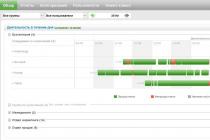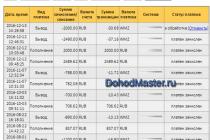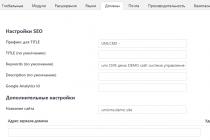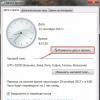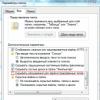Ministry of Education of the Republic of Belarus
Educational institution
"Belarusian State University
informatics and radioelectronics "
Department of Metrology and Standardization
Parametric measuring transducers
Methodical instructions for laboratory work E.5B
for students of specialty 54 01 01 - 02
"Metrology, standardization and certification"
all forms of education
UDC 621.317.7 + 006.91 (075.8)
BBK 30.10ya73
Compiled by V.T. Revin, L.E. Bataille
The methodological instructions contain the purpose of the work, brief information from the theory, a description of the laboratory installation, the laboratory assignment and the procedure for performing the work, as well as instructions for preparing the report and control questions to test students' knowledge. The main types of parametric measuring transducers (rheostatic, inductive and capacitive), their main characteristics and circuits for connecting to the measuring circuit are considered. The laboratory work involves the determination of the main metrological characteristics (conversion function, sensitivity, basic error, sensitivity determination error) of the considered measuring transducers, as well as mastering the technique of measuring non-electrical quantities using measuring transducers and finding errors in determining the values of non-electrical quantities.
UDC 621.317.7 + 006.91 (075.8)
BBK 30.10 i 73
1 Purpose of work
1.1 Study of the principle of operation, design and main characteristics of rheostat, capacitive and inductive measuring converters of non-electrical quantities into electrical ones.
1.2 Study of methods for measuring non-electrical quantities using rheostat, capacitive and inductive measuring transducers.
1.3 Practical determination of the main characteristics of measuring transducers and measurement with their help of linear and angular displacements.
2 Summary of theory
A feature of modern measurements is the need to determine the values of a set of physical quantities, among which non-electrical quantities make up most of them. To measure non-electrical quantities, electrical measuring instruments are widely used, which is due to a number of their significant advantages. These include high measurement accuracy, high sensitivity and high-speed performance of measuring instruments, the possibility of remote measurements, automatic conversion of measurement information, automatic control of the measurement process, etc. A feature of electrical measuring instruments designed to measure non-electrical quantities is the mandatory presence of a primary measuring transducer of non-electrical quantities into electrical ones.
The primary measuring transducer establishes an unambiguous functional relationship between the output electrical quantity Y and the input non-electrical quantity X: Y= f(X).
Depending on the type of output signal, the primary measuring transducers are subdivided into parametric and generator.
V parametric In measuring transducers, the output quantity is the parameter of the electrical circuit: resistance R, inductance L, mutual inductance M or capacitance C. When using parametric measuring transducers, an additional power source is always required, the energy of which is used to form the output signal of the converter.
V generator measuring transducers, the output quantities are EMF, current, voltage, or charge. When using generator measuring transducers, auxiliary power supplies are used only to amplify the received signal.
According to the principle of operation, parametric measuring transducers are subdivided into rheostat, strain-gauge (strain gauges), temperature-sensitive (thermistors, thermistors), capacitive, inductive, ionization.
Dependence of the output value of the measuring transducer Y on the input value X, described by the expression Y = f (X), called conversion function. Often the output value of the converter Y depends not only on the input measured value X, but also from some external factor Z... Therefore, in general form, the transformation function can be represented by functional dependence: Y = f (X, Z).
When developing measuring transducers of non-electrical quantities, one strives to obtain a linear conversion function. To describe the linear transformation function, it is sufficient to set two parameters: the initial value of the output quantity Y 0 (zero level), corresponding to zero or another initial value of the input quantity X, and the parameter S, which characterizes the slope of the transformation function.
In this case, the transformation function can be represented as follows:
The parameter S, which characterizes the slope of the conversion function, is called the sensitivity of the transducer. Transducer sensitivity is the ratio of the change in the output quantity of the measuring transducer ΔY to the change in the input quantity ΔX that caused it:
 . (2)
. (2)
The sensitivity of the transducer is a quantity that has a dimension, and the dimension depends on the nature of the input and output quantities. For a rheostat converter, for example, the sensitivity has a dimension of Ohm / mm, for a thermoelectric converter mV / K, for a photocell μA / lm, for a motor rev / (sV) or Hz / V, for a galvanometer mm / μA and etc.
The most important problem in the design and use of a measuring transducer is to ensure the consistency of its sensitivity. The sensitivity should depend as little as possible on the values of the input quantity X (in this case, the transformation function is linear), the rate of change of X, the operating time of the converter, as well as the impact of other physical quantities that characterize not the object itself, but its environment (such quantities are called influencing). With a non-linear transformation function, the sensitivity depends on the values of the input quantity: S = S(X) .
The range of values of non-electrical quantities, converted using a measuring transducer, is limited on the one hand by the conversion limit, and on the other - by the sensitivity threshold.
Conversion limit of the converter is the maximum value of the input quantity that can be perceived by the converter without damaging it or distorting the conversion function.
Sensitivity threshold Is the minimum change in the value of the input quantity that can cause a noticeable change in the output quantity of the converter.
Ratio Y = f(X) expresses in a general theoretical form the physical laws underlying the operation of converters. In practice, the transformation function is determined experimentally in numerical form as a result of the transducer calibration. In this case, for a number of precisely known values of X, the corresponding values of Y are measured , which allows you to build a calibration curve (Figure 1, a). Using the constructed calibration curve, according to the values of the electrical quantity Y obtained as a result of measurement, it is possible to find the corresponding values of the desired non-electrical quantity X (Figure 1, b).

a- construction of a calibration curve according to the measured values of X and Y;
b using a calibration curve to determine the input quantity X
Figure 1 Calibration characteristic of the measuring transducer
The most important characteristic of any measuring transducer is its basic error, which is due to the principle of operation, imperfection of the design of the converter or the technology of its manufacture and manifests itself at normal values of the influencing quantities or when they are within the range of normal values.
The basic error of the measuring transducer can have several components due to:
The inaccuracy of the exemplary measuring instruments, with the help of which the conversion function was determined;
The difference between the real calibration characteristic and the nominal conversion function; approximate (tabular, graphical, analytical) expression of the transformation function;
Incomplete coincidence of the conversion function with increasing and decreasing of the measured non-electrical quantity (hysteresis of the conversion function);
Incomplete reproducibility of the characteristics of the measuring transducer (most often sensitivity).
When calibrating a series of converters of the same type, it turns out that their characteristics are somewhat different from each other, occupying a certain band. Therefore, in the passport of the measuring transducer, a certain average characteristic is given, called nominal. Differences between the nominal (passport) and real characteristics of the converter are considered as its errors.
The calibration of the measuring transducer (determination of the real conversion function) is carried out using measuring instruments for non-electrical and electrical quantities. As an example, Figure 2 shows a block diagram of a setup for calibrating a rheostat transducer. A ruler is used as a means of measuring linear displacement (non-electrical quantity), and a digital meter L, C, R E7-8 is used for measuring electrical quantities - active resistance.

Figure 2 - Block diagram of the installation for the calibration of the rheostat transducer
The process of calibrating the transducer is as follows. With the help of the movement mechanism, the movable contact (slider) of the rheostat transducer is sequentially installed on the digitized marks of the ruler scale, and at each mark, the active resistance of the transducer is measured using the E7-8 device. The measured values of linear displacement and active resistance are entered in the calibration table 1.
Table 1
In this case, we obtain the transformation function of the measuring transducer, given in tabular form. To obtain a graphical image of the transformation function, you must use the recommendations given in Figure 1, a.
However, it should be borne in mind that the measurement of the linear displacement and active resistance was made with an error due to the instrumental errors of the measuring instruments used. In this regard, the definition of the transformation function was also made with some error (Figure 3).

Figure 3 - Errors in determining the conversion function
Since the sensitivity of the transducer S, given by the slope of the conversion function, is determined by the formula (2), then the calculation of the error in determining the sensitivity of the converter Δ S should be carried out on the basis of an algorithm for calculating the error of the result of an indirect measurement. In general, the calculation formula for Δ S as follows:
where  ,
,
Δ y 1 and Δ y 2 - errors in determining the output quantities y 1 and y 2,
Δ x 1 and Δ x 2 - errors in determining the input quantities x 1 and x 2.
Additional errors of the measuring transducer, due to its principle of operation, imperfection of design and manufacturing technology, appear when the influencing quantities deviate from normal values.
In addition to the characteristics discussed above, measuring converters of non-electrical quantities into electrical ones are characterized by: output signal variation, output impedance, dynamic characteristics. The most important technical characteristics also include: dimensions, weight, resistance to mechanical, thermal, electrical and other overloads, reliability, ease of installation and maintenance, explosion safety, manufacturing cost, etc. ...
Transmitters vary according to the signal conversion principle.
When analog direct conversion(Figure 4) the measured non-electrical quantity X is fed to the input of the primary measuring transducer (PID). The output electrical quantity Y of the transducer is measured by an electrical measuring device (ETI), which includes a measuring transducer and an indicating device.

Figure 4 Block diagram of a device with analog direct conversion of the measured non-electrical quantity
Depending on the type of output quantity and the requirements for the device, an electrical measuring device can be of varying degrees of complexity. In one case, it is a magnetoelectric millivoltmeter, and in the other, it is a digital measuring device. Usually, the scale of the EIT indicator device is graduated in units of the measured non-electrical quantity. The measured non-electrical quantity can be repeatedly converted to match the limits of its measurement with the conversion limits of the PID and obtain a more convenient type of input action for the PIP. To perform such transformations, one introduces into the device preliminarilybodily converters of non-electrical quantities to non-electrical.
With a large number of intermediate converters in direct conversion devices, the total error increases significantly. To reduce the error, apply differential frommeasuring transducers, which have a lower additive error, less non-linear conversion function and higher sensitivity compared to direct conversion devices.
Figure 5 shows a block diagram of a device with a differential measuring transducer (DIP). The converter includes a differential DZ link with two outputs, two conversion channels (P1 and P2) and a subtractor VU. When the input measured value x changes from the initial value x 0 to the value (x 0 + Δx), the output values x 1 and x 2 at the output of the remote sensing receive increments with different signs. After converting them into P1 and P2, the values at the output of the converters y 1 and y 2 are subtracted. As a result, the output value of the DIP (y = y 1 -y 2), supplied to the measuring mechanism of the MI, is proportional only to the increment Δx of the measured non-electrical quantity.

Figure 5 - Block diagram of a device with a differential conversion of a measured non-electrical quantity
In devices with transformation based on the principle of compensation (balancing) in the comparison device of the US of the converter, a comparison is made measurable magnitude and homogeneous mutable the value created by the feedback node of the UOS (Figure 6) Comparison of the values is carried out until they are completely balanced. Inverse converters are used as feedback nodes that convert an electrical quantity into a non-electrical one (for example, incandescent lamps, electromechanical converters, etc.).

Figure 6 - Block diagram of a device with a compensation measuring transducer
Compensation comparison devices in comparison with direct conversion devices allow obtaining higher accuracy, faster response, and less energy consumption from the object of study.
Electrical devices for measuring non-electrical quantities can be either analog or digital.
Rheostat converters
Rheostat converters are based on a change in the electrical resistance of a conductor under the influence of an input quantity - linear or angular displacement. A rheostat transducer is a rheostat (a frame with a wire winding applied to it), the movable contact of which makes a linear or angular movement under the influence of the measured non-electrical quantity. Schematic images of some designs of rheostat converters are shown in Figure 6, a-c. The dimensions of the transducer are determined by the limiting values of the measured displacement, the resistance of the winding and the electrical power dissipated in the winding. To obtain a nonlinear transformation function, functional rheostat converters are used. The required form of the conversion function is achieved by profiling the converter frame (Figure 6, v).
In rheostat converters, the static characteristic of the conversion has a stepwise character, since the resistance changes in jumps equal to the resistance of one turn. This causes the appearance of the corresponding error, the maximum value of which can be represented as:
 , (4)
, (4)
where R the maximum resistance of one turn;
R is the impedance of the converter.
V rechordal transducers in which the movable contact slides along the axis of the wire, this error can be avoided.
Rheostat converters are included in measuring circuits in the form of equilibrium and non-equilibrium bridges, voltage dividers, etc.

Figure 7 - Rheostat measuring transducers
The main disadvantages of rheostat converters are the presence of a sliding contact, the need for relatively large movements, and sometimes a significant effort to move. The advantages include simplicity of design and the ability to obtain significant output signals.
Rheostat transducers are used to measure relatively large linear and angular displacements, as well as other non-electrical quantities that can be converted into displacement (force, pressure, etc.).
Inductive converters
The principle of operation of inductive converters is based on the dependence of the intrinsic or mutual inductances of the windings on the magnetic circuit on the relative position, geometric dimensions and magnetic resistance of the elements of the magnetic circuit. It is known from electrical engineering that inductance L a winding located on a magnetic core (magnetic circuit) is determined by the expression:
 , (5)
, (5)
where Z M is the magnetic resistance of the magnetic circuit;
w the number of turns of the winding.
Mutual inductance M two windings located on one magnetic circuit with magnetic resistance Z M is defined as
 , (6)
, (6)
where w 1 and w 2 the number of turns of the first and second windings.
The magnetic resistance is determined by the expression:
 , ` (7)
, ` (7)
|
where |
active component of magnetic resistance; |
|
l i, S i, i |
, respectively, the length, cross-sectional area and relative magnetic permeability of the i-th section of the magnetic circuit; |
|
magnetic constant; |
|
|
length and cross-sectional area of the air section of the magnetic circuit; |
|
|
|
reactive component of magnetic resistance; |
|
power losses in the magnetic circuit due to eddy currents and hysteresis; |
|
|
angular frequency; |
|
|
magnetic flux in the magnetic circuit. |
The above relations show that the inductance and mutual inductance can be changed by changing the length δ or section S of the air section of the magnetic circuit, the power loss P in the magnetic circuit, etc.
Figure 8 shows schematically the different types of inductive converters. A change in the mutual inductance can be achieved, for example, by moving the movable core (armature) 1 relative to the fixed core 2, by introducing a non-magnetic metal plate 3 into the air gap (Figure 8 a).



Figure 8 - Inductive measuring transducers
Inductive transducer with variable length of air gap (Figure 8, b) is characterized by a nonlinear dependence L = f ( ). Such a transducer has high sensitivity and is usually used when the armature of the magnetic circuit is moved within the range of 0.01 5 mm.
Significantly less sensitivity, but linear dependence of the transformation function L = f(S) the converters with a variable cross-section of the air gap differ (Figure 8, v). Such transducers are used when measuring displacements up to 10 15 mm.
Inductive differential converters are widely used (Figure 8, G), in which a movable armature is placed between two fixed cores with windings. When the armature moves under the influence of the measured value simultaneously and with different signs, the lengths change δ 1 and δ 2 air gaps of the converter, while the inductance of one winding will increase and the other will decrease. Differential converters are used in combination with bridge measuring circuits. Compared to nondifferential converters, they have a higher sensitivity, less nonlinearity of the conversion function, and are less influenced by external factors.
To convert relatively large displacements (up to 50 - 100 mm), transformer converters with an open magnetic circuit are used (Figure 8, d).
If the ferromagnetic core of the converter is subjected to mechanical action by force F, then due to a change in the magnetic permeability of the core material, the magnetic resistance of the circuit will change, which will also entail a change in the inductance L and the mutual inductance M of the windings. The principle of operation of magnetoelastic transducers is based on this dependence (Figure 8, e).
Inductive transducers are used to measure linear and angular displacements, as well as other non-electrical quantities that can be converted into displacement (force, pressure, torque, etc.). The design of the transducer is determined by the range of the measured displacements. The dimensions of the transducer are selected based on the required output signal power.
For measuring the output parameter of inductive converters, bridge (equilibrium and non-equilibrium) and generator measuring circuits, as well as circuits with using resonant circuits that have the greatest sensitivity due to the large slope of the conversion function.
In comparison with other displacement transducers, inductive transducers are distinguished by high output signals, simplicity and reliability in operation.
Their main disadvantages are: the reverse effect on the object under study (the effect of the electromagnet on the armature) and the effect of the armature inertia on the frequency characteristics of the device.
Capacitive converters
The principle of operation of capacitive measuring transducers is based on the dependence of the capacitance of the capacitor on the dimensions, the mutual arrangement of its plates and the dielectric constant of the medium between them.
The electrical capacitance of a flat capacitor with two plates is described by the expression:
 ,
(8)
,
(8)
From this expression it can be seen that a capacitive converter can be built based on the use of dependencies C =f( ), C =f(S) or C = f( ).
Figure 9 schematically shows the design of various capacitive converters.


Figure 9 - Capacitive measuring transducers
The converter in Figure 9, a is a capacitor, one plate of which moves under the action of the measured non-electrical quantity X relative to the fixed plate. The static characteristic of the transducer using the dependence C =f( ) is non-linear. The sensitivity of the transducer increases with decreasing distance between the plates . Such transducers are used to measure small displacements (less than 1 mm).
Differential capacitive converters are also used (Figure 9, b), which have one movable and two fixed plates. Under the influence of the measured value X, these transducers simultaneously change the capacitances C1 and C2.
In Figure 9, v shows a differential capacitive converter with a variable active area of plates, which uses the dependence C =f(S) ... Transducers with this design are used to measure relatively large displacements. In these converters, the required conversion characteristic can easily be obtained by profiling the plates.
Converters Using Dependency C =f( ) They are used to measure the level of liquids, the moisture content of substances, the thickness of dielectric products, etc. As an example in Figure 9, G the device of the capacitive level transmitter is shown. The capacity between the electrodes lowered into the vessel depends on the level of the liquid.
To measure the output parameter of capacitive measuring transducers, bridge, generator measuring values and circuits using resonant circuits are used. The latter make it possible to create devices with high sensitivity, which are capable of responding to linear displacements of the order of 10 μm. Circuits with capacitive converters are usually supplied with a high frequency current (up to tens of MHz).
The output quantity in parametric converters is the parameter of the electrical circuit - electrical resistance or its components (R, L, C). To use a parametric converter, an additional power supply is required to provide the output signal of the converter.
The most commonly used parametric converters are rheostat, strain-sensitive (strain gauges), thermosensitive (thermistors or resistance thermometers), inductive, capacitive, optoelectronic(photoresistors, photodiodes and etc.), ionization and etc.
Operating principle rheostat converters based on the change in the electrical resistance of the conductor under the influence of the input value - mechanical movement. A rheostat transducer (Fig. 3.1) is a rheostat, the movable contact of which is stirred under the action of the measured non-electrical quantity. The transformer winding is made of alloys (platinum with iridium, constantan, nichrome, fechral, etc.).
Such converters have a static conversion characteristic with a step character, since the resistance is measured in steps equal to the resistance of one turn, which causes an error
where DR is the resistance of one turn;
R is the impedance of the transducer.


This error is absent in rechordal transducers in which the brush slides along the axis of the wire.
To obtain a nonlinear transformation function, apply functional rheostatic converters. The desired character of the transformation is often achieved by profiling the transducer frame (Figure 3.1, c).
Advantages of a rheostat transducer: relative simplicity of design, the ability to obtain high conversion accuracy and significant output signals. The main disadvantage is the presence of a sliding contact.
Strain effect underlying work strain gages, consists in measuring the active resistance of a conductor (semiconductor) under the influence of mechanical stress and deformation caused in it.
If the wire is subjected to mechanical stress, for example, stretching, then its resistance will change. Relative change in wire resistance
D R / R = S ∙ D l / l,
where S- coefficient of tensosensitivity;
D l / l- relative deformation of the wire.
The change in the resistance of the wire under mechanical action on it is explained by the change in the geometric dimensions (length, diameter) and the resistivity of the material.
Strain-Sensitive Wirewound Transducers represent a thin zigzag wire laid and glued to the substrate. The transducer is installed in such a way that the direction of the expected deformation coincides with the longitudinal axis of the wire cage. As a material for the converter, constantan wire is usually used (constantan has a low temperature coefficient of resistance) and for the substrate - thin paper (0.03 ... 0.05 mm) and a film of varnish or glue (BF-2, BF-4, bakelite and etc.).
Distribution also received foil converters which use foil instead of wire, and film strain gauges obtained by sublimation of a strain-sensitive material with its subsequent deposition on a substrate.
Advantages of strain gages: linearity of the static characteristics of conversion, simplicity of design and small dimensions. The main disadvantage is low sensitivity.
In cases where high sensitivity is required, they are used semiconductor strain-sensitive transducers (polycrystalline from a powdery semiconductor and monocrystalline from a silicon crystal). Since the sensitivity of semiconductor strain gauges is tens of times higher than that of metal ones, and, in addition, the integral technology makes it possible to simultaneously form both strain gauges and a microelectronic processing unit in a single silicon crystal, in recent years, integral semiconductor strain gauge converters have been predominantly developed. Such elements are realized either by the technology of diffusion resistors with their isolation from the conducting silicon substrate by pn junctions - the "silicon on silicon" technology, or by the heteroepitaxial technology "silicon on dielectric" on glass ceramics, quartz or sapphire. For strain-sensing transducers, especially semiconductor ones, the effect of temperature on their elastic and electrical characteristics is significant, which requires the use of special schemes for temperature compensation of errors (in particular, for this purpose, in the extended circuit strain bridge compensation resistors and thermistors are used). Especially widespread use in the manufacture pressure measuring transducers due to its high mechanical, insulating and heat-resistant qualities, the KNS technology - "silicon on sapphire" was obtained.
Improvement of the technology for the manufacture of semiconductor strain gages has made it possible to manufacture strain gages directly on a crystalline element made of silicon or sapphire. Elastic elements of crystalline materials have elastic properties approaching ideal. The adhesion of the strain gage to the membrane due to molecular forces makes it possible to abandon the use of adhesives and improve the metrological characteristics of the transducers. Figure 3.2, a shows a sapphire membrane 3 with single-strip strain gauges located on it p-type with positive 1 and negative 2 sensitivities. A strain gage has a positive sensitivity, in which the ratio is> 0, but if<0 – чувствительность отрицательна.
The structure of a single-strip strain gauge is shown in Figure 3.2, b. Here: 1 - strain gauge; 2 - protective covering; 3 - metallized conductive paths; 4 - an elastic element of the transducer (sapphire membrane). Strain gages can be placed on the membrane so that upon deformation they will have resistance increments of different sign. This makes it possible to create bridge circuits, in each of the arms of which strain gauges with the corresponding value and even temperature compensation elements are included.
Strain gages are used to measure deformations and other non-electrical quantities - forces, pressures, moments, etc.
 Operating principle thermistor based on the dependence of the electrical resistance of conductors or semiconductors on temperature. According to the operating mode, thermistors are distinguished overheating and without intentional overheating... Overheating is used to measure the speed, density, composition of the medium, etc. In overheating converters, electric current causes overheating, depending on the properties of the medium. The latter are used to measure the ambient temperature.
Operating principle thermistor based on the dependence of the electrical resistance of conductors or semiconductors on temperature. According to the operating mode, thermistors are distinguished overheating and without intentional overheating... Overheating is used to measure the speed, density, composition of the medium, etc. In overheating converters, electric current causes overheating, depending on the properties of the medium. The latter are used to measure the ambient temperature.
Thermistors made of copper or platinum wire have become widespread. Standard platinum thermistors used to measure temperature in the range from –260 to +1100 ° С, copper- in the range from –200 to +200 ° С (GOST 6651–78). Low-temperature platinum thermistors (GOST 12877–76) are used to measure temperatures in the range from –261 to –183 ° С.
In Figure 3.3, a shows the device of the platinum thermistor. In the channels of the ceramic tube 2 there are two (or four) sections of the spiral 3 made of platinum wire, connected in series.
 |
Figure 3.3 - Arrangement and appearance of platinum fittings
resistance thermometer
Leads are soldered to the ends of the spiral 4, used to connect the thermistor to the measuring circuit. The fastening of the leads and the sealing of the ceramic tube is carried out with glaze 1 ... The channels of the tube are covered with anhydrous alumina powder, which acts as an insulator and retainer for the spiral. Powder of anhydrous aluminum oxide, which has high thermal conductivity and low heat capacity, provides good heat transfer and low inertia of the thermistor. To protect the thermistor from mechanical and chemical influences of the external environment, it is placed in protective fittings (Figure 3.3, b) made of stainless steel.
For copper thermistors, the dependence of resistance on temperature is expressed by the equation
R = R 0 ∙ (1+ α t) at -50 0 С ≤ t≤ +180 0 С,
where R 0 - resistance at t= 0 0 C; α = 4.26 ∙ 10 –3 K –1. For platinum -
R = R 0 ∙ at 0 0 С ≤ t≤ +650 0 С,
where A = 3.968 ∙ 10 –3 K –1; B = 5.847 ∙ 10 –7 K –2; WITH= –4.22 ∙ 10 –12 K –4.
In addition to platinum and copper, thermistors are used to make nickel(in non-CIS countries).
Semiconductor thermistors ( thermistors and posistors) of various types, which are characterized by high sensitivity (the temperature coefficient of resistance of the TCR thermistors is negative and at 20 ° C is 10-15 times higher than the TCR of copper and platinum, the TCR of posistors is positive and somewhat worse) and have higher resistances (up to 1 MΩ) at very small sizes. The disadvantage of thermistors is poor reproducibility and non-linearity of the conversion characteristics.
Thermistors are used over a temperature range of –60 to + 120 ° C.

where R and R 0 - resistance of the thermistor at temperatures, respectively, t and t 0;
t 0 - initial temperature of the working range;
B is the conversion factor.
Temperature-sensitive converters also include thermal diodes and thermal transistors, in which when the temperature changes, the resistance value of the pn junction changes. These devices are usually used in the range from –80 ° to + 150 ° C. Most often, thermal diodes and thermistors are included in bridge circuits and measuring circuits in the form of voltage dividers. The advantages of such converters include high sensitivity and reliability, small dimensions, low cost and low response time. The main disadvantages are: a narrow range of operating temperatures and poor reproducibility of the static characteristics of the converter.
Operating principle inductive converters based on the dependence of the inductance or mutual inductance of the windings on the magnetic circuit on the position, geometric dimensions and magnetic state of the elements of their magnetic circuit (Figure 3.4). Figure 3.4 schematically shows the different types of inductive converters. Inductive converter (Figure 3.4, a) with variable air gap lengthδ is characterized by a nonlinear dependence L = f (δ). Such a transducer is usually used when the armature moves by 0.01-5 mm.
 |
 |
 |

Figure 3.4 - Various designs of inductive converters
Significantly less sensitivity, but linear dependence L = f (s) transducers with a variable cross-section of the air gap differ (Fig. 3.4, b). These transducers are used for displacements up to 10 ... 15 mm.
Widespread inductive differential converters(Figure 3.4, v), in which, under the influence of the measured value, two gaps of electromagnets change simultaneously and, moreover, with different signs. Differential transducers in combination with an appropriate measuring circuit (usually bridge) have a higher sensitivity, less nonlinearity of the conversion characteristic, experience less influence from external factors and a reduced resulting force on the armature from the electromagnet than non-differential transducers.
In Figure 3.4, G the circuit is shown differential inductive converter, in which the output quantities are mutual inductances. Such converters are called mutually inductive or transformer. When the primary winding is supplied with alternating current and with the symmetrical position of the armature relative to the electromagnets, the EMF at the output terminals is zero. When the armature moves, EMF appears on the output terminals.
To convert relatively large displacements (up to 50 ... 100 mm) use open circuit transformer(Figure 3.4, e).
The mining industry has spread magnetoelastic transducers(Figure 3.4, e), the action of which is based on the use of the effect of the dependence of the magnetic permeability (magnetic resistance of the circuit) on the magnitude of the mechanical action (compression or tension) on the ferromagnetic core of the converter. Distinguish between magnetoelastic sensors throttle and transformer types. The latter can only control the compression force, but they are more sensitive.
The advantages of inductive and magnetoelastic converters are simplicity and reliability in operation, significant power of the output signals. The main disadvantages are the reverse effect of the transducer on the object under study (the effect of the electromagnet on the armature) and the effect of the armature inertia on the frequency characteristics of the device.
Operating principle capacitive converters based on the dependence of the capacitance of the capacitor on the dimensions, the mutual arrangement of its plates and on the value of the dielectric constant of the medium between them. They are capacitors of various designs that convert mechanical linear or angular displacements, as well as pressure, humidity, or the level of the medium into a change in electrical capacitance.
v)


Figure 3.5 - Various designs of capacitive converters
Apply also differential converters(Figure 3.5, b), which have one movable and two fixed plates. Under the influence of the measured value X these converters change capacitances at the same time WITH 1 and WITH 2 . Such transducers are used to measure relatively large linear (more than 1 mm) and angular displacements. In these converters, it is easy to obtain the required conversion characteristic by profiling the plates.
Converters Using C = Dependency f 1 () is used to measure the level of liquids, the moisture content of substances, the thickness of dielectric products, etc. For an example (Figure 3.5, c ) let's bring the device capacitive level gauge... The capacitance between the electrodes lowered into the vessel depends on the level of the liquid, since a change in the level leads to a change in the average dielectric constant of the medium between the electrodes. By changing the configuration of the plates, it is possible to obtain the desired character of the dependence of the instrument readings on the volume (mass) of the liquid.
To measure the output parameter of capacitive converters, bridge circuits and circuits using resonant circuits are used. The latter make it possible to create devices with high sensitivity, capable of responding to displacements of the order of 10–7 mm. Circuits with capacitive converters are usually supplied with a current of increased frequency (up to tens of megahertz), which is caused by the desire to increase the signal entering the measuring device and the need to reduce the shunting effect of the insulation resistance.
Semiconductor photosensitive converters as a sensitive element have a photosensitive layer deposited on a substrate (glass plate). The resistance of this layer is inversely proportional to the intensity of the luminous flux or the power of the light source. Photoresistors, photodiodes and phototransistors have a relatively high stability, good sensitivity, but their use is limited in the presence of dust, such as coal, which interferes with normal operation.
Action ionization converters based on the phenomenon of gas ionization or the luminescence of certain substances under the influence of ionizing radiation. Used as ionizing agents a–, b– and g– rays of radioactive substances, sometimes X-rays and neutron radiation... The choice of the type of ionization converter depends largely on the ionizing radiation. Gamma rays(electromagnetic vibrations of small wavelength - 10 –8… 10 –11 cm) have a high penetrating ability.
The designs of ionization chambers and counters are varied and depend on the type of radiation. Cobalt-60, strontium-90, plutonium-239, etc. are usually used as sources of ionizing radiation.
The advantages of ionization converters are the possibility of non-contact measurements in aggressive or explosive environments, high temperature or high pressure environments. The main disadvantage: the need to use biological protection with a high activity of the radiation source.
Generator converters
V generator converters the output quantity is an EMF or charge, functionally related to the measured non-electrical quantity.
Consider the most common types of generator converters.
Thermoelectric converters operate on the thermoelectric effect that occurs in the circuit thermocouple: at a temperature difference in points 1 and 2 (Figure 3.6) the connection of two dissimilar conductors in the thermocouple circuit occurs thermoEMF.
Connection point of conductors (electrodes) 1 called the working end of the thermocouple, points 2 and 2" - free ends. In order for the thermoEMF in the thermocouple circuit to be unambiguously determined by the temperature of the working end, the temperature of the free ends of the thermocouple must be kept the same and unchanged. Thermoelectric thermometers are usually calibrated at a free end temperature of 0 ° C. Calibration tables for standard thermocouples are also compiled under the condition that the temperature of the risers is 0 ° C. In the practical application of thermoelectric thermometers, the temperature of the free ends of the thermocouple is usually not equal to 0 ° C and therefore it is necessary to introduce a correction.
Tachogenerators designed to measure the angular velocity of rotating objects. The rotor of tachogenerators is mechanically connected to the shaft of the tested electric motor or actuator, and about the angular speed w judged by the output EMF of the generator.
Of the tachogenerators, the most widespread are DC tachogenerators, produced with permanent magnets or with independent excitation. The area of their application is very diverse: precision DC tachogenerators are used in aviation, shipbuilding, machine tool building, metallurgical and other industries. The advantages of these sensors include a fairly high accuracy and the presence of a direct current output signal, convenient for subsequent processing. The main disadvantage of these tachogenerators is the presence of a collector-brush assembly, which reduces the reliability and durability of the converter.
Synchronous tachogenerators have a low internal resistance, which allows you to get quite high power from them. When the rotor speed changes in synchronous machines, not only the amplitude of the output voltage changes, but also its frequency. Due to their mechanical stability, synchronous tachogenerators are used in trams, locomotives, crane facilities, etc.
Asynchronous tachogenerators similar in design to two-phase induction motors. Their rotors are usually made in the form of a thin-walled metal cylinder. The two stator windings of the tachogenerator are shifted 90 ° relative to each other. A supply voltage is applied to one winding, and the EMF is removed from the measuring winding. When a supply voltage of constant value and frequency is applied, a pulsating magnetic flux, crossing the rotor, induces an EMF in the measuring winding, proportional to the angular velocity w a rotor driven by a controlled machine or mechanism. The main advantage of asynchronous tachogenerators is that, regardless of the rotor speed, the alternating current EMF at the output of such a tachogenerator has a constant frequency.
The main disadvantages of tachogenerators include a limited frequency range of measured values. In recent years, tachogenerators are gradually being replaced. photopulse and induction sensors, as well as special intellectual converters - encoders of angular movement (position).
V photopulse sensors pulses in an optoelectronic pair, a radiation source - a radiation receiver (LED - photoconverter) are created using disks with slots or holes; in some drives, rotating machine parts are used. Overwhelmingly position encoders also use an optoelectronic pair as a sensitive element.
Impulses induction sensors created under the influence of a pulsating or alternating magnetic flux. Special gears or rotating ferromagnetic parts of machines serve as the body that modulates the flux.
Piezoelectric converters use the effect of the appearance of electric charges on the surface of some crystals (quartz, tourmaline, Rochelle salt, etc.) under the influence of mechanical stresses.

Figure 3.7
Device piezoelectric transducer for measuring variable gas pressure is shown in Figure 3.7. Pressure R through a metal membrane 1 transmitted to sandwiched between metal spacers 2 quartz plates 3 ... Ball 4 promotes uniform pressure distribution over the surface of quartz plates. The middle gasket is connected to the terminal 5 passing through a sleeve of good insulating material. When exposed to pressure R between withdrawal 5 and a potential difference arises in the transmitter housing
Practical work No. 4
Ministry of Education of the Republic of Belarus
Educational institution
"Belarusian State University
Informatics and Radioelectronics "
Department of Metrology and Standardization
PARAMETRIC MEASURING
CONVERTERS
Methodical instructions for laboratory work E.5B
For students of specialty 45 01 01
"Metrology, standardization and certification"
All forms of education
Minsk 2004
UDC 621.317.7 + 006.91 (075.8)
BBK 30.10ya73
F 18
Compiled by V.T. Revin
The methodological instructions contain the purpose of the work, brief information from the theory, a description of the laboratory installation, the laboratory assignment and the procedure for performing the work, as well as instructions for preparing the report and control questions to test students' knowledge. The paper considers the main types of parametric measuring transducers (rheostatic, inductive and capacitive), their main characteristics and circuits for connecting to the measuring circuit. It provides for an assessment of the accuracy of the obtained measurement results and a comparative metrological assessment of devices for measuring non-electrical quantities, which are based on the principle of operation of the considered measuring transducers.
UDC 621.317.7 + 006.91 (075.8)
BBK 30.10 i 73
1 Purpose of work
1.1 Study of the principle of operation, design and main characteristics of rheostat, capacitive and inductive measuring converters of non-electrical quantities into electrical ones.
1.2 Study of methods for measuring non-electrical quantities using rheostat, capacitive and inductive measuring transducers.
1.3 Practical determination of the main characteristics of measuring transducers and measurement with their help of linear and angular displacements.
2 Summary of theory
A characteristic feature of modern measurements is the need to determine the values of a set of physical quantities, a significant number of which are non-electrical. For the measurement of non-electrical quantities, electrical measuring instruments are widely used, which is due to a number of their advantages (high measurement accuracy, high sensitivity and speed of measuring instruments, the possibility of transmitting measurement information over long distances, etc.). A feature of electrical measuring instruments designed to measure non-electrical quantities is the mandatory presence of a primary measuring transducer of non-electrical quantities into electrical ones.
The primary measuring transducer (PIM) establishes an unambiguous, functional dependence of the natural output electrical quantity Y on the natural input non-electrical quantity X. Depending on the type of the output signal, all primary measuring transducers are subdivided into parametric and generator ones. In parametric measuring transducers, the output quantity is the parameter of the electrical circuit (resistance R, inductance L, mutual inductance M and capacitance C). When using parametric measuring transducers, an additional power source is required, the energy of which is used to generate the output signal of the transducer. In generator measuring transducers, the output quantity is EMF, current or voltage, functionally related to the measured non-electrical quantity.
According to the principle of operation, parametric measuring transducers are subdivided into rheostatic, thermoresistive, tensoresistive, inductive, capacitive and ionization.
The dependence of the output quantity of the measuring transducer Y on the input quantity X is called the conversion function and is described by the expression Y = f (X). Often, for converters, the output value Y depends not only on the input measured value X, but also on the external factor Z. Therefore, in general form, the conversion function can be represented by the following functional dependence: Y = f (X, Z).
When creating measuring converters of non-electrical quantities, one strives to obtain a linear conversion function. To describe the linear transformation function, two parameters are sufficient: the initial value of the output quantity Y 0 (zero level) corresponding to zero or some other characteristic value of the input quantity X, and the index of the relative slope of the transformation function
, (1)
called the sensitivity of the transducer. Transducer sensitivity is the ratio of the change in the output of the transmitter to the change in the input value that causes it. Typically, it is a named quantity with a variety of units depending on the nature of the input and output quantities. For a rheostat transducer, for example, the unit of sensitivity is Ohm / mm, for a thermoelectric converter mV / K, for a photocell μA / lm, for a motor rev / (sV) or Hz / V, for a galvanometer mm / μA and etc.
In this case, the transformation function can be represented as an expression
 . (2)
. (2)
The most important problem in the design and use of the converter is to ensure constant sensitivity, which should depend as little as possible on the values of X
(determining the linearity of the transformation characteristics) and the frequency of their changes, from time and the impact of other physical quantities that characterize not the object itself, but its environment (they are called quantities influencing the measurement results).
However, the sensitivity of each transducer is constant only in a certain section of the conversion function, which is limited, on the one hand, by the conversion limit, and on the other, by the sensitivity threshold.
The conversion limit of a given converter is the maximum value of the input quantity that can still be perceived by it without distorting and damaging the converter.
Threshold is the smallest change in the input quantity that can cause a noticeable change in the transmitter output. The value of the sensitivity threshold is usually determined to be equal to half of the ambiguity band of the transformation function at small values of the input quantity.
With a non-linear conversion function, the sensitivity depends on the value of the input quantity.
By measuring the value of the output signal Y of the converter, it is possible to determine the value of the input value X (Figure 1). The ratio Y = = F (X) expresses in a general theoretical form the physical laws underlying the operation of converters. For all converters, the transformation function - the ratio Y = F (X) in numerical form is determined experimentally as a result of calibration. In this case, for a number of precisely known values of X, the corresponding values of Y are measured ,
which allows you to build a calibration curve (Figure 1, a). From this curve, for all the values of Y obtained as a result of measurement, the corresponding values of the required quantity X can be found (Figure 1, b).
| a  | b |
a- obtaining a calibration curve for the known values of the measured value X;
b using a calibration curve to determine X
Figure 1 Calibration characteristics of the measuring transducer
An important characteristic of any measuring transducer is its basic error, which can be due to the principle of operation, imperfection of the design or technology of its manufacture and manifests itself at normal values of the influencing quantities or when they are within the normal range. The basic error of the measuring transducer can have several components due to:
The inaccuracy of the exemplary measuring instruments, with the help of which the conversion function was determined;
The difference between the real calibration characteristic and the nominal conversion function; approximate (tabular, graphical, analytical) expression of the transformation function;
Incomplete coincidence of the conversion function with increasing and decreasing of the measured non-electrical quantity (hysteresis of the conversion function);
Incomplete reproducibility of the characteristics of the measuring transducer (most often sensitivity).
When calibrating a series of converters of the same type, it turns out that their characteristics are somewhat different from each other, occupying a certain band. Therefore, in the passport of the measuring transducer, a certain average characteristic is given, called nominal. Differences between the nominal (passport) and real characteristics of the converter are considered as its errors.
The calibration of the measuring transducer (determination of the real conversion function) is carried out using measuring instruments for non-electrical and electrical quantities. The block diagram of the installation for calibrating the rheostat transducer is shown in Figure 2. A ruler is used as a means of measuring linear displacement (non-electrical quantity), and a digital meter L, C, R E7-8 is used for measuring electrical quantities - active resistance. 
Figure 2 - Block diagram of the installation for the calibration of the rheostat transducer
The process of calibrating the transducer is as follows. With the help of the movement mechanism, the movable contact (slider) of the rheostat transducer is sequentially installed on the digitized marks of the ruler scale, and at each mark, the active resistance of the transducer is measured using the E7-8 device. The measured values of linear displacement and active resistance are entered in the calibration table 1.
Table 1
In this case, we obtain the transformation function of the measuring transducer, given in tabular form. When obtaining a graphic image of the conversion function, you must use the recommendations given in Figure 1, a... But it should be borne in mind that the measurement of linear displacement and active resistance was made with an error caused by the instrumental errors of the measuring instruments used. In this regard, the definition of the conversion function was also made with an error (Figure 3). Since the definition of the conversion function was carried out by indirect measurements, then the assessment of its error should be carried out as the error of the result of indirect measurement by the formula
 , (3)
, (3)
Where  ,
,  partial derivatives; Y, X - instrumental errors of measuring instruments.
partial derivatives; Y, X - instrumental errors of measuring instruments.
R 
Figure 3 - Definition of the conversion function and its errors
Additional errors of the measuring transducer, due to its principle of operation, imperfection of design and manufacturing technology, appear when the influencing quantities deviate from normal values.
In addition to the characteristics discussed above, measuring converters of non-electrical magnitudes into electrical ones are characterized by: nominal static conversion characteristic, output signal variation, output impedance, dynamic characteristics. The most important non-metrological characteristics include: dimensions, weight, ease of installation and maintenance, explosion protection, resistance to mechanical, thermal, electrical and other overloads, reliability, manufacturing cost, etc. ...
As already noted, a feature of measuring instruments designed to measure non-electrical quantities is the mandatory presence of a primary measuring transducer of non-electrical quantities into electrical ones. A simplified block diagram of a direct conversion electrical device for changing non-electrical quantities is shown in Figure 4.
The measured non-electrical quantity X is fed to the input of the primary measuring transducer (PIM). The output electrical quantity Y of the transducer is measured by an electrical measuring device (ETI), which includes a measuring transducer (MT) and an indicator device of the DUT. Depending on the type of output quantity and the requirements for the device, an electrical measuring device can be of varying degrees of complexity. In one case, it is a magnetoelectric millivoltmeter, and in the other, it is a digital measuring device. Usually, the EIT scale is graduated in units of the measured non-electrical quantity. 
Figure 4 Connection diagram of the primary measuring transducer
The measured non-electrical quantity can be repeatedly converted to match the limits of its measurement with the conversion limits of the PID and obtain a more convenient type of input action for the PIP. To perform such conversions, preliminary converters of non-electrical quantities into non-electrical ones are introduced into the device.
With a large number of intermediate transformations in direct assessment devices, the total error increases significantly. To reduce the error, differential measuring transducers (DIP) are used, which have a lower additive error, a lower nonlinearity of the conversion function and increased sensitivity compared to similar nondifferential converters.
Figure 5 shows a block diagram of a device that includes a differential measuring transducer (DIP). The peculiarity of this circuit is the presence of two conversion channels and a differential DIP link with one input and two outputs. When measuring the input value X relative to the initial value X 0, the output values of the DIP receive increments with different signs relative to the initial value. Consequently, with a change in the input value, the informative parameter of the signal of one channel increases, while that of the other decreases. The output values of the channels are subtracted in the subtractive device (WU) and form the output value Y, which is measured by an electrical measuring device.
At present, comparison devices are used to measure non-electrical quantities, which allow, in comparison with direct conversion devices, to obtain higher accuracy, faster response and ensure less energy consumption from the object of research. Inverse converters are used as feedback nodes, converting an electrical quantity into a non-electrical one. 
Figure 5 - Connection diagram of a differential measuring
Converter
Electrical instruments for measuring non-electrical quantities can be not only analog, but also digital.
Rheostat converters
Rheostat converters are based on a change in the electrical resistance of a conductor under the influence of an input quantity - linear or angular displacement. A rheostat transducer is a rheostat, the movable contact of which moves under the influence of the measured non-electrical quantity. A schematic representation of some designs of rheostat transducers for angular and linear displacement is shown in Fig. 6, a, b... The converter consists of a winding applied to the frame and a movable contact. The dimensions of the transducer are determined by the value of the measured displacement, the resistance of the winding and the power dissipated in the winding. To obtain a nonlinear transformation function, functional rheostat converters are used. The required character of the transformation is achieved by profiling the transducer frame (Figure 6, v).
In the considered rheostatic converters, the static characteristic of the transformation has a stepwise character, since the resistance changes in jumps equal to the resistance of one turn. This causes the appearance of an error, the maximum value of which is determined by the expression
 ,
,
Rheostat converters are included in measuring circuits in the form of equilibrium and non-equilibrium bridges, voltage dividers, etc.
R 
Figure 6 - Rheostat measuring transducers
The advantages of converters include the ability to obtain high conversion accuracy, significant output signals and relative simplicity of design. The disadvantages are the presence of sliding contact, the need for relatively large movements, and sometimes a significant effort to move.
Rheostat converters are used to convert relatively large displacements and other non-electrical quantities (force, pressure, etc.) that can be converted into displacement.
Inductive converters
The principle of operation of inductive converters is based on the dependence of the inductance or mutual inductance of coils with a core on the position, geometric dimensions and magnetic resistance of the elements of their magnetic circuit. So, the inductance of the winding located on the magnetic core (Figure 7, a), is determined by the expression  , (4)
, (4)
The mutual inductance of two windings located on the same magnetic circuit is determined as
 , (5)
, (5)
Where w 1 and w 2 are the number of turns of the first and second windings of the converter.
The magnetic resistance is determined by the expression
Z M = R M + X M, (6)
| where  | active component of magnetic resistance; |
| l i, s i, i | , respectively, the length, cross-sectional area and magnetic permeability of the i-th section of the magnetic circuit; |
| 0 | magnetic constant; |
| | length of the air gap; |
| s | cross-sectional area of the air section of the magnetic circuit; |
 | reactive component of magnetic resistance; |
| R | power losses in the magnetic circuit due to eddy currents and hysteresis; |
| | angular frequency, |
| F | magnetic flux in the magnetic circuit. |
The above relations show that the inductance and mutual inductance can be changed by acting on the length l, the cross-section of the air section of the magnetic circuit s, for the power loss in the magnetic circuit and in other ways. This is achieved by moving the movable core (armature) 1 relative to the fixed core 2, introducing a non-magnetic metal plate 3 into the air gap, etc. ...
Figure 6 shows schematically the different types of inductive converters. Inductive transducer with variable length of air gap (Figure 7, b) is characterized by a nonlinear dependence L = f (). Such a converter is usually used when moving the armature of the magnetic circuit up to 0.01 5 mm. Transducers with a variable cross-section of the air gap differ significantly less sensitivity, but a linear dependence of the transformation function L = f (s) (Figure 7, v). These transducers are used for displacements up to 10 15 mm.
Inductive differential converters are widespread (Figure 7, G), in which, under the influence of the measured value, two gaps of the electromagnets change simultaneously and with different signs. Differential transducers in combination with an appropriate measuring circuit (usually bridge) have a higher sensitivity, less nonlinearity of the conversion function, are less influenced by external factors and a reduced resulting force on the armature from the electromagnet than non-differential transducers.

| a | b |

| v | G |

| d | e |
Figure 7 - Inductive measuring transducers
To convert relatively large displacements (up to 50 - 100 mm), transformer converters with an open magnetic circuit are used (Figure 7, d).
If the ferromagnetic core of the converter is subjected to mechanical stress F, then due to a change in the magnetic permeability of the core material, the magnetic resistance of the circuit will change, which will also entail a change in the inductance L and the mutual inductance M of the windings. The principle of operation of magnetoelastic converters is based on this dependence (Figure 7, e).
The design of the transducer is determined by the range of the measured displacement. The dimensions of the transducer are selected based on the required output signal power.
For measuring the output parameter of inductive converters, bridge (equilibrium and non-equilibrium) and generator measuring circuits, as well as circuits with using resonant circuits that have the highest sensitivity due to the large steepness of the resulting conversion function.
Inductive transducers are used to measure linear and angular displacement, as well as other non-electrical quantities that can be converted into displacement (force, pressure, torque, etc.).
In comparison with other displacement transducers, inductive transducers are distinguished by high output signals, simplicity and reliability in operation.
Their main disadvantages are: the reverse effect on the object under study (the effect of the electromagnet on the armature) and the effect of the armature inertia on the frequency characteristics of the device.
Capacitive converters
The principle of operation of capacitive measuring transducers is based on the dependence of the capacitance of the capacitor on the dimensions, the mutual arrangement of its plates and the dielectric constant of the medium between them.
For a two-layer flat capacitor, the electrical capacitance is
 ,
,
It can be seen from the expression for the capacitance that the converter can be built using the dependencies С = f (), С = f (s), C = f ().
Figure 8 schematically shows the design of various capacitive converters. Converter (Figure 8, a) is a capacitor, one plate of which moves under the action of the measured value X relative to the fixed plate. The static characteristic of the converter С = f () is nonlinear. The sensitivity of the transducer increases with decreasing distance . Such transducers are used to measure small displacements (less than 1 mm).
Differential capacitive converters are also used (Figure 8, b), which have one movable and two fixed plates. Under the influence of the measured value X, these transducers simultaneously change the capacitances C1 and C2. In Figure 8, v shows a differential capacitive converter with a variable active area of the plates. Such a transducer is used to measure relatively large displacements. In these converters, it is easy to obtain the required conversion characteristic by profiling the plates.

| a | b |

| v | G |
Figure 8 - Capacitive measuring transducers
Converters using the relationship C = f () are used to measure the level of liquids, the moisture content of substances, the thickness of dielectric products, etc. As an example in Figure 8, G the device of the capacitive level transmitter is shown. The capacity between the electrodes, pubescent in the vessel, depends on the level of the liquid.
To measure the output parameter of capacitive measuring transducers, bridge, generator measuring values and circuits using resonant circuits are used. The latter make it possible to create devices with high sensitivity, which are capable of responding to linear displacements of the order of 10 μm. Circuits with capacitive converters are usually supplied with a high frequency current (up to tens of MHz).
3.2 Laboratory setup.
4 Description of the laboratory setup
The laboratory setup used in performing the work is a collection of laboratory models, each of which can be used independently of the others.
The M1 model provides a study of the main characteristics of rheostat, capacitive and inductive measuring transducers. The transducers are equipped with a mechanical device that provides linear and angular displacement of the moving part of the transducers and control of the digital values of these displacements. The outputs of all measuring transducers are switched to the breadboard output by means of the OUTPUT switch. The OPTION switch provides a change in the initial value of the active resistance, capacitance and inductance of the corresponding measuring transducers, as well as their conversion function. A diagram of the M1 laboratory layout is shown in Figure 9, and the appearance of its front panel is shown in Figure 12.

Figure 9 - Electrical schematic diagram of the laboratory model M1
The M2 model (Figure 10) implements the measuring circuits used with rheostat measuring transducers: a voltage divider and an unbalanced bridge. With the help of a switch of the kind of work that switches the power supply, indicator device and measuring transducers, various variants of measuring circuits are implemented: a voltage divider with the inclusion of a measuring transducer as resistance R3 (position 1) and an unbalanced bridge with measuring transducer R4 (position 2). The appearance of the front panel of the M2 layout is shown in Figure 13.

Figure 10 - Electrical schematic diagram of the laboratory layout M2
The M3 model (Figure 11) is intended for the practical determination of the linear and angular displacements of the measuring object and is a set of rheostatic and capacitive transducers in conjunction with mechanical devices for moving the moving part of the measuring transducers. Mechanical devices are equipped with letter scales, with the help of which the variants of the laboratory assignment are carried out. The front panel of the M3 layout is shown in Figure 14.

Figure 11 Electrical schematic diagram of laboratory layout M3

Figure 12 - External view of the front panel of the laboratory layout M1 
Figure 13 - External view of the front panel of the laboratory layout M2

Figure 14 - External view of the front panel of the laboratory layout M3
5 Preparation for work
5.1 According to the recommended literature, to study in detail the device and principle of operation and the main characteristics of rheostat, capacitive and inductive measuring transducers ,
circuits for connecting measuring transducers into measuring circuits and methods for measuring non-electrical quantities using parametric measuring transducers.
5.2 According to Appendix A of the presented methodological instructions for laboratory work, study the device, the principle of operation and operation of the digital meter L, C, R Е7-8, used in laboratory work, as well as the methodology for carrying out measurements with its help and assessing the errors of the obtained measurement results.
5.3 Make a report preparation (one per team) on laboratory work in accordance with the requirements of these guidelines (section 8).
5.4 Answer security questions.
5.5 Solve the problem. 
Figure 15 - Schematic representation of a capacitive measuring
variable area transducer
The task
Measurement of the angular displacement and the object was carried out using a capacitive transducer with a variable area of the plates (Figure 15). Plate 1 is rigidly connected to the shaft and is mixed relative to plate 2
so that the value of the air gap between them remains unchanged. Determine the value of the angular displacement , if the initial С Н and final С К values of the transducer capacitance are measured. The values of r, CH, C K and are given in table 2.
table 2
| Parameter | Option |
|||||||||
| 1 | 2 | 3 | 4 | 5 | 6 | 7 | 8 | 9 | 10 |
|
| r, mm | 10 | 10 | 10 | 10 | 10 | 10 | 10 | 10 | 10 | 10 |
| C H, pF | 70 | 20 | 46 | 40 | 10 | 24 | 20 | 50 | 70 | 30 |
| C K, pF | 90 | 30 | 50 | 60 | 20 | 28 | 40 | 60 | 74 | 50 |
| , mm | 0,1 | 0,2 | 0,5 | 0,1 | 0,2 | 0,5 | 0,1 | 0,2 | 0,5 | 0,1 |
Note. Dielectric constant in free space (8.854160.00003) 10 -12 F / m.
6 Lab assignment
6.1 Determine the conversion functions, sensitivity and conversion errors of rheostat, capacitive and inductive measuring transducers.
6.2 Investigate the measuring circuits of rheostat, capacitive and inductive measuring transducers.
6.3 Measure the linear and angular displacement of the measured object using rheostatic, capacitive and inductive measuring transducers, the characteristics of which are given in table 6 of these guidelines.
7 Work order
7.1 Perform measurements in accordance with clause 6.1 of the laboratory task. It is recommended to carry out measurements in the following sequence.
7.1.1 Prepare the E7-8 device for measurements of active resistance in accordance with paragraph 5 of Appendix A of the methodological instructions for laboratory work.
7.1.2 Set the reading device of the M1 breadboard measuring transducers to the zero position and connect the input of the E7-8 device to the output terminals of the M1 breadboard using the connecting conductors.
7.1.3 Set the required conversion functions of the M1 breadboard transducers by setting the OPTION switch to the position corresponding to the brigade number. Connect a rheostat measuring transducer to the output of the M1 breadboard by setting the OUTPUT switch to the R position.
7.1.4 Define the conversion functions of the rheostat measuring transducer. To do this, set the pointer of the reading device of the M1 layout sequentially to the scale marks indicated in Table 3, fixing the corresponding values of the active resistance R on the digital display of the E7-8 device. Enter the measurement results in Table 3. Return the pointer of the reading device of the M1 layout to the zero position.
7.1.5 Switch the E7-8 device to the inductance L measurement mode by setting the MEASUREMENT VIEW switches on the front panel of the E7-8 device to the L, R and G, R positions. Connect an inductive measuring transducer to the output of the M1 breadboard by setting the "OUTPUT" switch to position 1. Repeat the measurements in accordance with clause 7.1.4 of these methodological instructions. Enter the measurement results in Table 3.
Table 3
| Parameter designation | Parameters |
||||||||||
| Measured | Calculated |
||||||||||
| Transmitter scale divisions | S | Burial |
|||||||||
| 0,5 | 1,0 | 1,5 | 2,0 | 2,5 | 3,0 | 3,5 | … | 10,0 |
|||
| R, Ohm | |||||||||||
| R, Ohm | |||||||||||
| C, pF | |||||||||||
| C, pF | |||||||||||
| L, mH | |||||||||||
| L, mH | |||||||||||
7.1.6 Switch the E7-8 device to the mode of measuring the electrical capacitance C by setting the "MEASUREMENT VIEW" switches on the front panel of the E7-8 device to the positions C, G and tg . Connect a capacitive measuring transducer to the output of the M1 breadboard by setting the OUTPUT switch to position C. Repeat the measurements in accordance with clause 7.1.4 of these guidelines.
7.1.7 Based on the results of measurements (table 3), build graphs of functional dependencies R = f (X), L = f (X), C = f (X), where X are the values of the digitized marks of the scale of the M1 layout. Determine the sensitivity S of the rheostat, inductive and capacitive measuring transducers on the linear sections of the obtained conversion functions.
To determine the linear portions of the transformation function, calculate the values Y = Y i - Y i -1. The linear section of the transformation function is determined from the condition of approximate fulfillment of the equalities X = X i X i -1 = сonst, Y = Y i Y i - l = const. Enter the results of calculating Y and sensitivity S into Table 3.
7.1.8 Determine the error in determining the conversion function (calibration) of the measuring transducers (the error in determining the conversion function) as the error of indirect measurement, using the technical characteristics of the E7-8 device and the value of the error in reading the measured displacement values from the scale of the reading device of the measuring converters. Enter the calculated errors in table 3.
7.2 Carry out measurements in accordance with clause 6.2 of the laboratory task. It is recommended to carry out measurements in the following sequence.
Turn on the rheostat measuring transducer into the potentiometric measuring circuit by setting the switch for the type of operation of the M3 breadboard to position "1". Set the required transmitter conversion function by setting the OPTION switch to the position corresponding to your crew number. Set the reading device of the measuring transducer to the zero mark of the scale. Include layout.
Sequentially setting the pointer of the reading device to the digitized marks of the scale using the "scale" knob (imitating the linear or angular movement of the measurement object), fix the corresponding positions of the pointer of the magnetoelectric measuring mechanism. Enter the measurement results in Table 4.
7.2.3 Turn on the rheostat measuring transducer into the bridge measuring circuit by setting the MODE switch of the breadboard M2 to position "2". Repeat measurements in accordance with clause 7.2.2 of these guidelines. Enter the measurement results in table 4. Turn off the layout.
7.2.4 Plot the dependences = f (X) for potentiometric (position 1 of the MODE switch of the layout M2) and bridge (position 2 of the MODE switch of the layout M2) measuring circuits. Determine the sensitivity of the potentiometric and bridge meters using the linear portions of the conversion functions. Enter the sensitivity calculation results in Table 4.
Estimate the error in determining the sensitivity of measuring devices S taking into account the scale division of the reading device and indicator device as an error in the result of an indirect measurement with independent partial errors. Enter the results of calculating the error in table 4.
Table 4
| Operation switch position | Parameter designation | Parameters |
|||||||||||
| Measured | Calculated |
||||||||||||
| Measuring scale divisions converter, cm | S | Burial |
|||||||||||
| 1 | 2 | 3 | 4 | 5 | … | 11 | 12 | 13 | 14 |
||||
| 1 | I, mA | ||||||||||||
| 2 | I, mA | ||||||||||||
LECTURE 16.
Parametric measuring transducers
Resistance thermometers.
Resistance thermometers, like thermocouples, are designed to measure the temperature of gaseous, solid and liquid bodies, as well as surface temperature. The principle of operation of thermometers is based on the use of the properties of metals and semiconductors to change their electrical resistance with temperature. For conductors made of pure metals, this dependence in the temperature range from –200 o C to 0 o C has the form:
R t = R 0,
and in the temperature range from 0 o C to 630 o C
R t = R 0)







